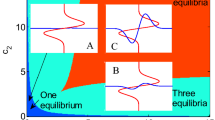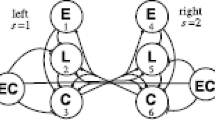Abstract
Many neuronal circuits driving coordinated locomotion are composed of chains of half-center oscillators (HCOs) of various lengths. The HCO is a common motif in central pattern generating circuits (CPGs); an HCO consists of two neurons, or two neuronal populations, connected by reciprocal inhibition. To maintain appropriate motor coordination for effective locomotion over a broad range of frequencies, chains of CPGs must produce approximately constant phase-differences in a robust manner. In this article, we study phase-locking in chains of nearest-neighbor coupled HCOs and examine how the circuit architecture can promote phase-constancy, i.e., inter-HCO phase-differences that are frequency-invariant. We use two models with different levels of abstraction: (1) a conductance-based model in which each neuron is modeled by the Morris–Lecar equations (the ML-HCO model); and (2) a coupled phase model in which the state of each HCO is captured by its phase (the phase-HCO model). We show that one of four phase-waves with inter-HCO phase-differences at approximately 0, 25, 50 or 75 % arises robustly as a result of the inter-HCO connection topology, and its robust existence is not affected by the number of HCOs in the chain, the difference in strength between the ascending and descending nearest-neighbor connections, or the number of nearest-neighbor connections. Our results show that the internal anti-phase structure of the HCO and an appropriate inter-HCO connection topology together can provide a mechanism for robust (i.e., frequency-independent) limb coordination in segmented animals, such as the 50 % interlimb phase-differences in the tripod gate of stick insects and cockroaches, and the 25 % interlimb phase-differences in crayfish and other long-tailed crustaceans during forward swimming.





Similar content being viewed by others
References
Chevalliera S, Ijspeertb AJ, Ryczkoa D, Nagya F, Cabelguen JM (2008) Organisation of the spinal central pattern generators for locomotion in the salamander: Biology and modelling. Brain Res Rev 57:147–161
Clewley R (2011) Inferring and quantifying the role of an intrinsic current in a mechanism for a half-center bursting oscillation. J Biol Phys 37:285–306
Cohen AH, Ermentrout GB, Kiemel T, Kopell N, Sigvardt KA, Williams TL (1992) Modeling of intersegmental coordination in the lamprey central pattern generator for locomotion. Trends Neurosci 15:434–438
Cohen AH, Holmes PJ, Rand RH (1982) The nature of the coupling between segmental oscillators of the lamprey spinal generator for locomotion: A mathematical model. J Math Biol 13:345–369
Cohen AH, Kiemel T (1993) Intersegmental coordination: lessons from modeling systems of coupled nonlinear oscilaltors. Am Zool 33:54–65
Collins JJ, Stewart I (1993) Coupled nonlinear oscillators and the symmetries of animal gaits. J Nonlinear Sci 3:349–392
Daun-Gruhn S, Toth TI (2011) An inter-segmental network model and its use in elucidating gait-switches in the stick insect. J Comput Neurosci 31:43–60
Ermentrout GB (1985) The behavior of rings of coupled oscillators. J Math Biol 23:55–74
Golubitsky M, Stewart I, Buono PL, Collins JJ (1999) Symmetry in locomotor central pattern generators and animal gaits. Nature 401:693–695
Grillner S (2006) Biological pattern generation: the cellular and computational logic of networks in motion. Neuron 52:751–766
Hill AA, Masino MA, Calabrese RL (2003) Intersegmental coordination of rhythmic motor patterns. J Neurophysiol 90:531–538
Hooper SL (2001) Central pattern generators. In: Encyclopedia of Life Sciences, electronic press at www.ELS.net. Macmillan Reference
Ijspeert AJ (2008) 2008 special issue: central pattern generators for locomotion control in animals and robots: A review. Neural Netw 21:642–653
Ijspeert AJ, Crespi A, Ryczko D, Cabelguen JM (2007) From swimming to walking with a salamander robot driven by a spinal cord model. Science 315:1416–1420
Ijspeert AJ, Kodjabachian J (1999) Evolution and development of a central pattern generator for the swimming of a lamprey. Artif Life 5:247–269
Kopell N, Ermentrout GB (1986) Symmetry and phaselocking in chains of weakly coupled oscillators. Commun Pure Appl Math 39:623–660
Kopell N, Ermentrout GB (1988) Coupled oscillators and the design of central pattern generators. Math Biosci 90:87–109
Kristan WB, Stent GS, Ort CA (1974) Neuronal control of swimming in the medicinal leech. i. dynamics of the swimming rhythm. J Comp Physiol 94:97–119
Kuramoto Y (1984) Cooperatiave dynamics of oscillator community. a study based on lattice of rings. Progress Theor Phys Suppl 79:223–240
Marder E, Calabrese RL (1996) Principles of rhythmic motor pattern generation. Physiol Rev 76:687–717
Mulloney B, Smarandache C (2010) Fifty years of CPGs: two neuroethological papers that shaped the course of neuroscience. Front Behav Neurosci 4:45
Mulloney B, Smarandache-Wellmann C (2012) Neurobiology of the crustacean swimmeret system. Progress Neurobiol 96:242–267
Proctor J, Kukillaya RP, Holmes P (2010) A phase-reduced neuro-mechanical model for insect locomotion: feed-forward stability and proprioceptive feedback. Philos Trans R Soc Lond A 368:5087–5104
Ren L, Ermentrout B (1998) Monotonicity of phaselocked solutions in chains and arrays of nearest-neighbor coupled oscillators. SIAM J Math Anal 29:208–234
Schwemmer MA, Lewis TJ (2012) Phase response curves in neuroscience. In: Schultheiss NW, Prinz AA, Butera RJ (eds) The theory of weakly coupled oscillators. Springer, New York
Sigvardt KA, Miller WL (1974) Analysis and modeling of the locomotor central pattern generator as a network of coupled oscillators. Ann N Y Acad Sci 860:250–265
Skinner FK, Kopell N, Marder E (1994) Mechanisms for oscillation and frequency control in reciprocally inhibitory model neural networks. J Comput Neurosci 1:69–87
Skinner FK, Kopell N, Mulloney B (1997) How does the crayfish swimmeret system work? insights from nearest neighbor coupled oscillator models. J Comput Neurosci 4:151–160
Skinner FK, Mulloney B (1998) Intersegmental coordination of limb movements during locomotion: Mathematical models predict circuits that drive swimmeret beating. J Neurosci 18:3831–3842
Smarandache C, Hall WM, Mulloney B (2009) Coordination of rhythmic motor activity by gradients of synaptic strength in a neural circuit that couples modular neural oscillators. J Neurosci 29:9351–9360
Smarandache-Wellmann C, Weller C, Mulloney B (2014) Mechanism of coordination in distributed neural circuits: decoding and integration of coordinating information. J Neurosci 34:793–803
Stein PSG (2007) Motor pattern deletions and modular organization of turtle spinal cord. Brain Res Rev 57:118–124
Taylor AL, Cottrell GW, Kristan WB (2002) Analysis of oscillations in a reciprocally inhibitory network with synaptic depression. Neural Comput 14:561–581
Toth TI, Grabowska M, Rosjat N, Hellekes K, Borgmann A, Daun-Gruhn S (2015) Investigating inter-segmental connections between thoracic ganglia in the stick insect by means of experimental and simulated phase response curves. Biol Cybern 109:349–362
Várkonyi PL, Kiemel T, Hoffman K, Cohen AH, Holmes P (2008) On the derivation and tuning of phase oscillator models for lamprey central pattern generators. J Comput Neurosci 25:245–261
Wang XJ, Rinzel J (1992) Alternating and synchronous rhythms in reciprocally inhibitory model neurons. Neural Comput 4:84–97
Williams TL, Sigvardt KA, Kopell N, Ermentrout GB, Remler MP (1990) Forcing of coupled nonlinear oscillators: studies of intersegmental coordination in the lamprey locomotor central pattern generator. J Neurophysiol 64:862–871
Zhang C, Guy RD, Mulloney B, Zhang Q, Lewis TJ (2014) The neural mechanism of optimal limb coordination in crustacean swimming. Proceedings of the National Academy of Sciences USA 111(38), 13,840–13,845
Zhang C, Lewis TJ (2013) Phase response properties of half-center oscillators. J Comput Neurosci 35:55–74
Acknowledgments
CZ and TJL were partially supported by NSF under grant number CRCNS 0905063. CZ is a Courant Instructor.
Author information
Authors and Affiliations
Corresponding author
Appendix: Numerical results of the ML-HCO model: inter-HCO connections with unequal strengths between the ascending and descending directions
Appendix: Numerical results of the ML-HCO model: inter-HCO connections with unequal strengths between the ascending and descending directions
In Sect. 4.1, we used the phase-HCO model to show that an approximate 0, 25, 50, or 75 % phase-waves persists regardless of the difference in strength between the ascending and descending connections. Here, we verify the above result using the conductance-based ML-HCO model. We consider a chain of 10 HCOs under the four fundamentally different inter-HCO connection topologies. Figures 6, 7, 8, 9 show that regardless of the ratio of the ascending to descending connection strengths, the deviation of the phase-differences is always in the order of \(O(\epsilon )\) (see Eq. 24 for definition of \(\epsilon \)). Both the phase-HCO model and the ML-HCO model give the same result that an asymmetry in the ascending and descending inter-HCO connection strength does not affect the existence of the four robust approximate phase-waves.
The effect of the difference in the synaptic strength between the ascending and descending inter-HCO connections on the phase-differences in a chain of 10 HCOs with inter-HCO connection topology (a1). The phase-differences \({\varDelta }\phi _k\) (Eq. 36) is plotted as a function of k, \(k=1,2,\ldots ,9\) for four different values of \(a = \alpha /\beta \), where \(\alpha \) and \(\beta \) are the strength of the ascending and descending connections, respectively. Numerical simulation of this ML-HCO model was performed using the same parameters reported in Sect. 2 (color figure online)
The effect of the difference in the synaptic strength between the ascending and descending inter-HCO connections on the phase-differences in a chain of 10 HCOs with inter-HCO connection topology (a2). See the caption and legend of Fig. 6 for descriptions (color figure online)
The effect of the difference in the synaptic strength between the ascending and descending inter-HCO connections on the phase-differences in a chain of 10 HCOs with inter-HCO connection topology (s1). See the caption and legend of Fig. 6 for descriptions (color figure online)
The effect of the difference in the synaptic strength between the ascending and descending inter-HCO connections on the phase-differences in a chain of 10 HCOs with inter-HCO connection topology (s2). See the caption and legend of Fig. 6 for descriptions (color figure online)
Rights and permissions
About this article
Cite this article
Zhang, C., Lewis, T.J. Robust phase-waves in chains of half-center oscillators. J. Math. Biol. 74, 1627–1656 (2017). https://doi.org/10.1007/s00285-016-1066-5
Received:
Revised:
Published:
Issue Date:
DOI: https://doi.org/10.1007/s00285-016-1066-5








